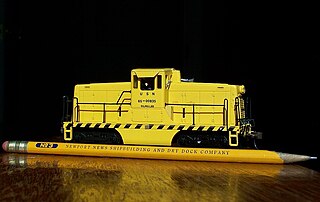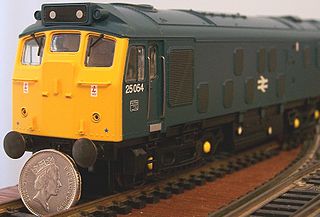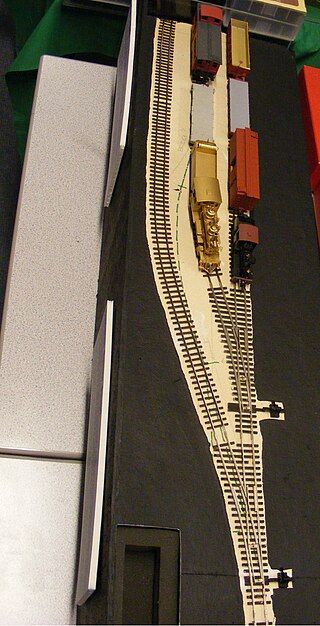
HO or H0 is a rail transport modelling scale using a 1:87 scale. It is the most popular scale of model railway in the world. The rails are spaced 16.5 millimetres (0.650 in) apart for modelling 1,435 mm standard gauge tracks and trains in HO.

N scale is a popular model railway scale. Depending upon the manufacturer, the scale ranges from 1:148 to 1:160. Effectively the scale is 1:159, 9 mm to 1,435 mm, which is the width of standard gauge railway. However the scale may vary to simulate wide or narrow gauge rail. In all cases, the gauge is 9 mm or 0.354 in. The term N gauge refers to the track dimensions, but in the United Kingdom in particular British N gauge refers to a 1:148 scale with 1:160 track gauge modelling. The terms N scale and N gauge are often inaccurately used interchangeably, as scale is defined as ratio or proportion of the model, and gauge only as a distance between rails. The scale 1:148 defines the rail-to-rail gauge equal to 9 mm exactly, so when calculating the rail or track use 1:160 and for engines and car wheel base use 1:148.

2 mm scale, often 2 mm finescale is a specification used for railway modelling, largely for modelling British railway prototypes. It uses a scale of 2 mm on the model to 1 foot on the prototype, which scales out to 1:152. The track gauge used to represent prototype standard gauge is 9.42 mm. Track and wheels are closer to dead scale replicas than commercial British N.

EM gauge is a variant of 4 mm to a foot (1:76) scale used in model railways.
David Jenkinson was a railway modeller and historian, who had a particular interest in the London, Midland and Scottish Railway (LMS) and was president of the LMS Society.

Pendon Museum, located in Long Wittenham near Didcot, Oxfordshire, England, is a museum that displays scale models, in particular a large scene representing parts of the Vale of White Horse in the 1920s and 1930s. The scene, under construction since the 1950s and with parts dating back earlier, was inspired by detailed research into the architecture and landscape of the vale, with some models of cottages taking hundreds of hours to complete. The late Roye England, an anglophile Australian who lived in England, founded it, and run jointly by the late English Model Maker, Guy Williams, who made fifty-seven of the museum's ninety locomotives.

The British Railways Standard Class 9F2-10-0 is a class of steam locomotive designed for British Railways by Robert Riddles. The Class 9F was the last in a series of standardised locomotive classes designed for British Railways during the 1950s, and was intended for use on fast, heavy freight trains over long distances. It was one of the most powerful steam locomotive types ever built for British Railways, and successfully performed its intended duties. The 9F class was given the nickname of 'Spaceship', due to its size and shape.

4 mm scale is the most popular model railway scale used in the United Kingdom. The term refers to the use of 4 millimeters on the model equating to a distance of 1 foot (305 mm) on the prototype (1:76.2). It is also used for military modelling.

BR Standard Class 9F number 92220 Evening Star is a preserved British steam locomotive completed in 1960. It was the last steam locomotive to be built by British Railways. It was the only British main line steam locomotive earmarked for preservation from the date of construction. It was the 999th locomotive of the whole British Railways Standard range.

Kalmbach Media is an American publisher of books and magazines, many of them railroad-related, located in Waukesha, Wisconsin.

The London, Midland and Scottish Railway (LMS) Royal Scot Class is a class of 4-6-0 express passenger locomotive introduced in 1927. Originally having parallel boilers, all members were later rebuilt with tapered type 2A boilers, and were in effect two classes.

The London, Midland and Scottish Railway (LMS) Garratt was a class of Garratt 2-6-0+0-6-2 steam locomotive designed for heavy freight. A total of 33 were built from 1927, making them the most numerous class of Garratt in Britain.

A fiddle yard or staging yard is a collection of model railway tracks that are hidden from view and allow trains to be stored and manipulated by the operators. These tracks are used to allow most model railways to be operated in a realistic manner. Whilst it is possible to have a realistic shunting yard in view, its operation is generally unreliable with models.

Laira Traction and Rolling Stock Maintenance Depot is a railway traction maintenance depot situated in Plymouth, Devon, England. The depot is operated by Great Western Railway (GWR) and is where their fleet of High Speed Trains are overhauled along with those belonging to CrossCountry. These will be withdrawn in 2023 but it will then become the principal depot for GWR's Class 802 InterCity Express Trains. Other trains visit for daily servicing.

Brent railway station was on the South Devon Railway, serving the village of South Brent on the southern edge of Dartmoor in Devon, England.
Proto:87 is a model railroad special interest group founded in 1978, providing a finescale alternative to traditional HO gauge.

00n3 is the description given to modelling 3 ft narrow gauge railways in 4 mm scale with 12 mm gauge track. 3 ft prototypes were common in Ireland and the Isle of Man, but the scale is not generally used outside the British Isles. 12 mm gauge track is the same as that used in TT scale and HOm, so some components used for those scales can be used.
In rail transport modelling, Sn3½ is a scale/gauge combination derived from S scale to represent narrow gauge 3 ft 6 in track by using 16.5 mm gauge track. The scale is 1:64.
This tabulation is for periodicals which do not have their own articles.















